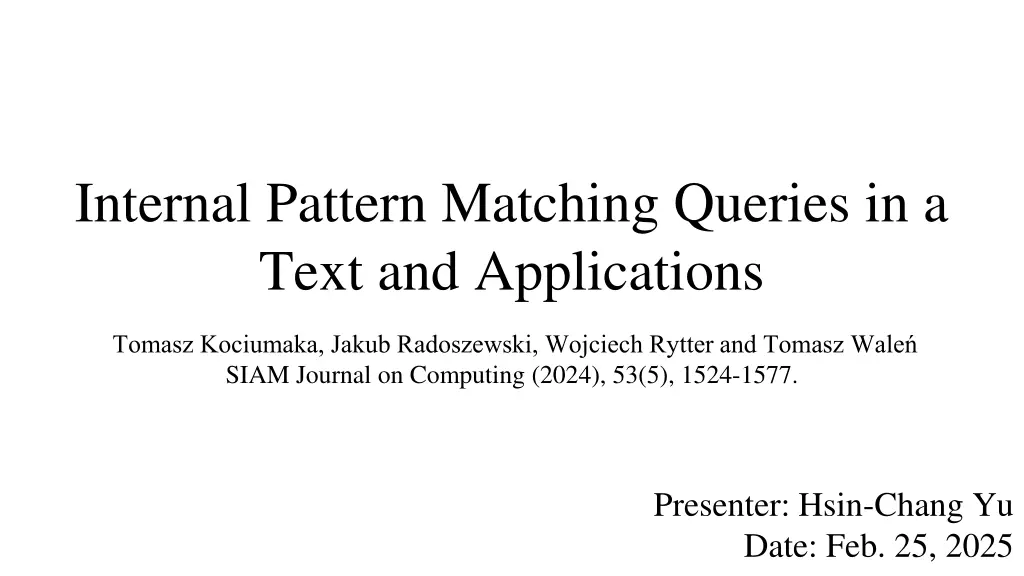
Optimal Data Structure for Internal Pattern Matching Queries
Explore an optimal data structure for internal pattern matching (IPM) queries in text processing, providing efficient solutions for exact pattern matching problems. The data structure offers optimal query response times proportional to the quotient of fragment lengths, with applications in various string processing tasks.
Uploaded on | 0 Views
Download Presentation

Please find below an Image/Link to download the presentation.
The content on the website is provided AS IS for your information and personal use only. It may not be sold, licensed, or shared on other websites without obtaining consent from the author. If you encounter any issues during the download, it is possible that the publisher has removed the file from their server.
You are allowed to download the files provided on this website for personal or commercial use, subject to the condition that they are used lawfully. All files are the property of their respective owners.
The content on the website is provided AS IS for your information and personal use only. It may not be sold, licensed, or shared on other websites without obtaining consent from the author.
E N D
Presentation Transcript
Internal Pattern Matching Queries in a Text and Applications Tomasz Kociumaka, Jakub Radoszewski, Wojciech Rytter and Tomasz Wale SIAM Journal on Computing (2024), 53(5), 1524-1577. Presenter: Hsin-Chang Yu Date: Feb. 25, 2025
Abstract We consider several types of internal queries, that is, questions about fragments of a given text T specified in constant space by their locations in T. Our main result is an optimal data structure for internal pattern matching (IPM) queries, which, given two fragments x and y, ask for a representation of all fragments contained in y and matching x exactly. This problem can be viewed as an internal version of the fundamental exact pattern matching problem: We are looking for exact occurrences of one substring of T within another substring of T. 2
Abstract Our data structure answers IPM queries in time proportional to the quotient |y|/|x| of fragments lengths, which is required due to the worst-case information content of the output. If T is a text of length n over an integer alphabet of size , then our data structure occupies O(n/log n) machine words (that is, O(nlog ) bits) and admits an O(n/log n)-time construction algorithm. We also show how to use IPM queries for answering internal queries corresponding to other classic string processing problems. 3
Abstract Among others, we derive optimal data structures reporting the periods of a fragment and testing the cyclic equivalence of two fragments. Since the publication of the conference version of this paper [Kociumaka et al., Internal pattern matching queries in a text and applications, SODA 2015], IPM queries have found numerous further applications, following the path paved by the classic longest common extension (LCE) queries of Landau and Vishkin [J. Comput. System Sci., 37 (1988), pp. 63-78]. 4
Abstract In particular, IPM queries have been implemented in grammar- compressed and dynamic settings and, along with LCE queries, constitute elementary operations of the PILLAR model, developed by Charalampopoulos, Kociumaka, and Wellnitz [Faster approximate pattern matching: A unified approach, FOCS 2020] to design approximate pattern matching algorithms that work in multiple settings. All our algorithms are deterministic, whereas the data structure in the conference version of the paper only admits a randomized construction in O(n) expected time. 5
Abstract To achieve this, we provide a novel construction of string synchronizing sets of Kempa and Kociumaka [String synchronizing sets: Sublinear-time BWT construction and optimal LCE data structure, STOC 2019]. Our method, based on a new restricted version of the recompression technique of Je [J. ACM, 63 (2016), pp. 4:1-4:51], yields a hierarchy of O(logn) string synchronizing sets covering the whole spectrum of the fragments' lengths. 6
Period Queries T = abbabbabbabb Period 2 abb Period 4 abbabb 11
2-Period Queries T = abbabbabbabb 2-Period abb 12
Prefix-Suffix Queries x = abababababa y = bababababababbabababa Answers: abababa 14
Cyclic Equivalence Queries abababababa aababababab rot1 17
Cyclic Equivalence Queries x = ababababab y = bababababa 18
Thanks 19
